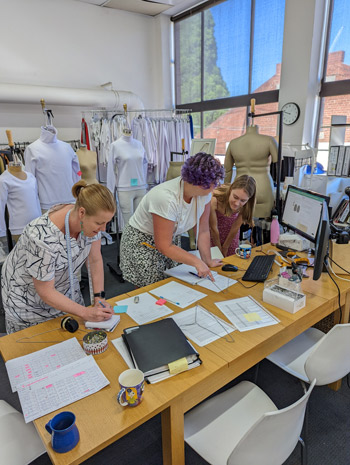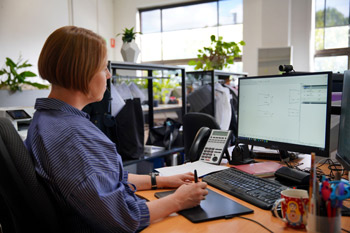PRINTING United Alliance is grateful to serve its members who make such significant impacts on the printing industry. Through our membership spotlights, we continue to recognize our members, and help our community get to know their peers professionally and personally. This spotlight features a Q&A with Pattern Room CFO Daniel Watts.
Please tell me a little about Pattern Room's story (when the company started/how it's evolved, its mission and offerings, etc.).

Pattern Room initially began in about 2013 to help fashion/clothing designers streamline the development process of key styles for their ranges, but competing interests meant that it was sidelined until 2019.
As a pattern maker with [about]
30 years of experience, Julia Van Der Sommen recognized that the process to get a pattern for “basic” styles like T-shirts, polos, hoodies, etc. was a lengthy, expensive, and complicated process, and yet many clients wanted the same, or
very similar, thing. She found herself recreating the same patterns over and over again [commonly hearing] “I just need a T-shirt that fits." A beautifully fitting garment starts with a great pattern.
As of today,
Pattern Room’s catalog of patterns extends to more than 200,000 styles and growing! The focus remains on those styles that are at the core of the decorator/dye-sublimation clothing business — T-shirts, singlets, pullovers, jackets, leggings,
shorts, and track pants. Whether it be a basketball uniform for a local team, some polos for that new business down the street, or a range of spiritwear so that your local teams can raise some funding from their adoring fans, the catalog has it.
The patterns in the Pattern Room catalog were all developed by our own in-house team in Melbourne, Australia and tested with physical samples before being made available. The patterns are in digital format, so perfect for the application of
graphics and colors and because they are digital, they are not at the mercy of the current freight challenges. Each pattern is usually available within 48 hours with fits for toddlers, kids, men, and women and from sizes 0000 (newborn) to 8XL in men’s
or 28 in women’s.
The team are constantly working on new styles and the catalog is ever expanding to provide an even greater ability to service most any sport, spirit wear or corporate application. We are only a team of 11 so
being efficient and effective with everything we do is critical for us.
Our mission is actually quite simple, starting with apparel decoration, we want to rid the world of bad-fitting clothing.
Can you explain more about Pattern Room's unique approach to apparel printing/decorating?
Pattern Room is very much focused on giving access to great fitting patterns to those who are printing and making their own apparel.
Pattern-making has long been one of the biggest hurdles in making your own product. Pattern Room
helps those who want their own products, whether this be decorated with screen printing, DTG, or dye-sublimation, to provide locally produced, high-quality apparel for most any application.
We see the traditional way of getting patterns
as something that will hold back an existing business from expanding their offering or replacing patterns that don’t work well as well as a business which is looking to bring in-house that making capability. The traditional process is slow, time
consuming, expensive, and the results can be inconsistent with other patterns already owned (e.g. differing fits or sizes). Being able to find the pattern that you want from a catalog, knowing that it fits the same way as all your other patterns and
accessing it within 48 hours and at lower cost opens the door to exploring new revenue streams quickly and effectively.
What are some of the technologies your operation uses?
Pattern Room has long been a digital pattern maker, using specialized CAD software to create our patterns. While 3D rendering software has made significant leaps in their abilities to “digitally sample” garments, there are also some shortcomings
that mean we have not yet turned to it to ensure our patterns create beautiful fits. We still utilize physical samples which we test on mannequins and also on fit models — especially for things like stretch garments, where body movement must
be considered.

We have recently implemented new technology on our website, which effectively allows the user to ‘create’ their own style (pattern) and we are looking at other relatively new technologies to help with rendering
this into a 3D avatar. This is a little way off though, as our team have been heavily focused on expanding the catalog.
While it might seem like our tech is not really at the cutting edge, Pattern Room is the first offering of its
kind in the world. The systems that we have had to develop behind the scenes are pretty crazy.
There has been a longtime concern regarding waste and the environmental impacts in the textile industry. How important is sustainability to not only Pattern Room, but your customers?
Environmental impact is at the forefront of everything we do. The textile industry has largely adopted models which are creating very significant environmental issues of which waste is one of the most significant.
We are approaching waste reduction in two key areas. [The first is] the reduction of samples in the development process. By developing the styles and the patterns ourselves, we can then provide a pattern, which we know that works, to many people the
world over, meaning every one of those clients no longer needs to go through the sampling process to get a beautifully fitted polo or hoodie or basketball singlet, etc. We’ve already done that for them. We hope that this will result in a very
significant reduction in fabric waste in the development stage.
[Secondly,] we have all found ourselves, at some point, with apparel that simply fits badly. These are the items in our wardrobes that get worn rarely or simply get thrown away. Or, you may return said garment, but it is actually more likely that garment will be destroyed rather than made available for sale again. Our mission is to rid the world of poorly fitting clothing. Imagine for a moment that every garment in your wardrobe fits beautifully and was well
made? There is a much greater likelihood that you will wear these many times, helping to reduce the waste created by over-production and unworn, poorly fitting apparel.
In both instances
we want to work closely with our clients to help them reduce both the waste created in the industry and [carbon footprints] through supporting a local supply chain.
How has Pattern Room navigated the past few years between the pandemic and its associated challenges (has the company been impacted by supply chain issues)?

Interestingly, we actually set out to launch Pattern Room in Dallas in March 2020. We walked off the plane after a 17-hour flight to find that all was not well with the world. We were lucky enough to spend a couple of great days in Dallas before frantically
trying to get ourselves on a flight back home. Only a short time later, Australia closed its borders even to citizens trying to get home.
Then the world stopped. Our clients are mostly those who are making sportswear for local sports
teams, corporate uniforms, and event apparel. But they are all resilient, mostly, small businesses, and turned their attention to other
things, some of which we were able to help with, like medical scrubs and tracksuits — the new working from home corporate uniform.
Since then, supply chain issues have actually helped us raise the profile of locally made apparel.
Whether that apparel is made in Dallas, Indianapolis, San Diego, Johannesburg, Georgetown, or just down the street from us in Melbourne. This is helping to reduce the reliance on supply of finished apparel. Yes, it still is reliant upon sourcing fabric,
but in many instances, there are local supplies.
We have actually seen a significant uptick in clients going from producing offshore or utilizing blanks (pre-made blanks) to alleviate size, color, style constraints by making their
own and capitalizing on stronger consumer sentiment to buy local. Some of those clients are now even making small runs of blanks for other apparel decorators in the same city, further boosting
local jobs and economies and exploring new revenue streams.
What are Pattern Room’s goals looking ahead?
It’s optimistic, but we are so confident in the fit and function of our patterns that we want customers to ask their local custom sportswear maker if they use Pattern Room patterns. In all seriousness, we
are actively engaging with both our clients and sporting bodies to design even better fitting apparel for specific sports and crucially for women.
We have a lengthy roadmap of new styles and categories (e.g., club swimwear) which we are working through and perfecting. That catalog will continue to offer even more options and we estimate
that we will get to something like 6 million styles before we start to run out of things to add.
We also have designs on setting up an office in the U.S. within the next 12-18 months. We’re still contemplating where we would like
that to be, but as very keen skiers, we’d like to think somewhere near some of the amazing skiing in the Rockies or Sierra Nevada mountains would be ideal. We welcome any suggestions!